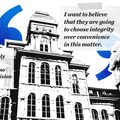Architecture seniors culminate design work with LA F[i]ESTA installations
![Architecture seniors culminate design work with LA F[i]ESTA installations](/resize/810/wp-content/uploads/2025/04/30203144/ca2_DOM_LeonardoEriman_AVE_-Arch_04302025-01-scaled.jpg)
FLE[X], one of three student architecture installations in the quad, was built to be flexible. The designers intended the X-shaped structure to be used for any kind of celebration. Leonardo Eriman | Asst. Video Editor
Get the latest Syracuse news delivered right to your inbox.
Subscribe to our newsletter here.
Corrine Soo grew up in Brooklyn, constantly surrounded by towering buildings that drew her in. She was captivated by their scale and intrigued by the way people interacted with the structural environment. Mostly, she was fascinated by the fact that humans brought them to life.
“This event needs the community to come to make it an event,” Soo said. “We can have our installations out, but the whole point of our project and of architecture in general is to activate space.”
Over the past five years, she has explored her fascination at Syracuse University’s School of Architecture. Soo and other fifth-year students celebrated the culmination of their education by participating in LA F[i]ESTA, a collaborative design-build project featured on the Shaw Quadrangle from Tuesday to Wednesday.
The event included a procession through three installations on the Quad. Each installation represents the work of a team of four students who researched, designed and built the project under the guidance of architecture professors Rosita Palladino and Magdalena Valdevenito. Students worked on LA F[i]ESTA throughout the semester as the culminating project in their final studio course, ARC 498: Directed Research.
To plan the event, students were split into three teams, which they referred to as “fiesta teams” Soo said. The site team was in charge of reaching out to SU to request permission for the installations to be on the Quad, ensuring they followed safety regulations.
The materials team was tasked with keeping an archive of all the resources they collected to ensure nothing went to waste. Finally, the public relations team reached out to people to spread the word about the event, Soo said.
“We are architecture students,” Soo said. “This is not our area of expertise, but we just had to figure it out along the way.”
At each installation, students explained the significance of their work and the inspiration behind their designs. Other architecture students, critics and professors discussed the installations as a group and congratulated the students on their hard work.
The first stop was a Thanksgiving Address by Diane Schenandoah of the Haudenosaunee Confederacy, delivered in front of Soo’s group’s installation on the Quad. Soo’s group’s design was called “STOP, GATHER, PLAY.” The installation played with the theme of elements in nature.
“STOP, GATHER, PLAY” featured modules representing each of the five elements: fire, earth, water, space and air. It included dirt, sand, plants and other natural components which visitors were encouraged to touch, inviting them to reconnect with the Earth through their interaction.

Along with creating design-build projects to be displayed on the Quad, architecture students had to handle other aspects of the exhibition. Corrine Soo said that handling the PR for the project pushed her out of her comfort zone. Leonardo Eriman | Asst. Video Editor
“A lot of the time we are all drawn into our internal world and we forget that we’re existing in space as well,” Soo said. “We want people to be able to just stop, gather around and experience it.”
Soo’s role on the PR team helped her step out of her comfort zone and learn how to initiate conversations with new people, she said.
The next stop in the procession was Isabella Klug and her group members’ installation in the Orange Grove in front of Carnegie Library, which they titled “F[R]AMED.” Klug grew up loving arts and crafts, often doing projects with her grandma to stimulate her creative mind. When she reached high school, she fell in love with math and science and knew she wanted a career combining her passions. She said she found this balance in architecture.
Klug’s installation was a ribbon-tying ceremony led by the class and student marshals. The group hoped to bring a tradition back to campus that took place 20 years ago.
Graduating seniors would make a wish, then tie a ribbon on the Orange Grove. The wish would supposedly come true a week after commencement. Klug’s group wanted to create something that was meaningful to the campus community and revolved around Orange Grove.
The Orange Grove is the only alumni landmark on campus for architecture. The group invited local alumni who didn’t have a chance to take part in the tradition when they graduated so they could visit the installation and tie a ribbon there. Klug said she hopes to inspire SU to keep the tradition going.
Finally, everyone was led by the marching band to Sofia Izer’s group’s installation called “FLE[X],” installed in front of Hendrick’s Chapel. As a child, Izer was equally drawn to the creativity of art and the logic of math. When someone once suggested she explore architecture, it stuck with her, ultimately shaping her path as she entered college.
The name “FLE[X]” comes from the idea that the installation itself is flexible. Not only does the form create an X shape, but it can be folded up and reconfigured in multiple ways for many different uses, like hosting a celebration. They planned to use their structure as a table for a Jenga game night on the second day of the event.
Izer said she was happy to be able to share her group’s project with the community.
“Sometimes in the school of architecture we’re holed up and we only talk to each other and no one really knows what we’re doing, so it’s really great to be out in the Quad where anyone can interact with it and be curious about it,” Izer said.
In the discussion following the last installation, one critic emphasized that, because architecture students essentially speak in their own language, it’s important to explain their work in a way that makes sense to others. Phrases like “ephemeral architecture” and “activate space” are part of their everyday vernacular, but they require further explanation for those unfamiliar with the terminology.
Ephemeral architecture refers to something brief, like many celebrations are, such as the Italian Easter celebrations that the students studied in class. Most buildings are meant to last, but like a celebration, the students’ designs in this installation are only up for 48 hours, requiring them to think about architecture in a new way.
“It’s impactful because it doesn’t last forever,” Izer said.






